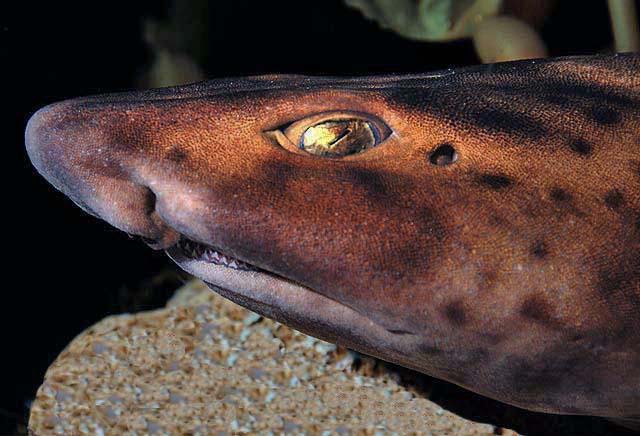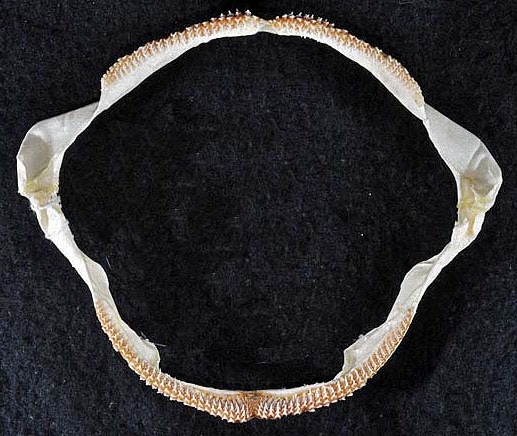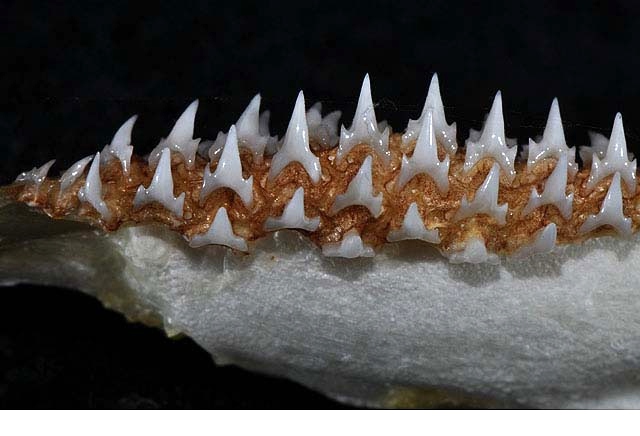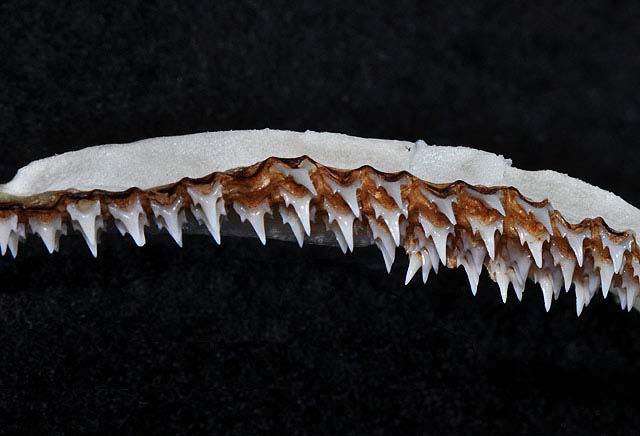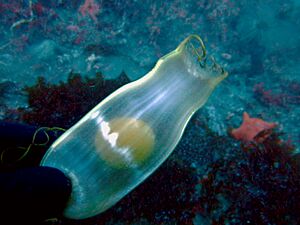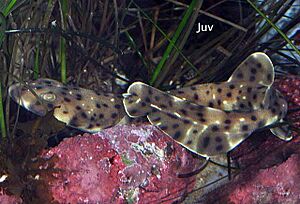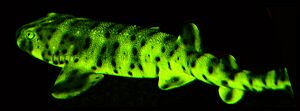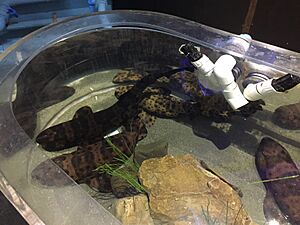Swell shark facts for kids
Quick facts for kids Swell shark |
|
|---|---|
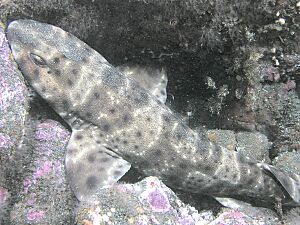 |
|
| A swell shark in its natural home | |
| Conservation status | |
| Scientific classification | |
| Genus: |
Cephaloscyllium
|
| Species: |
ventriosum
|
| Synonyms | |
|
|
The swell shark (Cephaloscyllium ventriosum) is a cool type of catshark. It lives in the warm parts of the eastern Pacific Ocean, from California all the way down to Mexico and even off the coast of Chile. This shark has a super neat trick: when it feels scared, it can gulp down water and puff itself up to twice its normal size! This makes it much harder for predators to eat.
Contents
What's in a Name? The Swell Shark's Identity
When scientists first found the swell shark in 1880, they gave it the name Scyllium ventriosum. Later, its name was changed to Cephaloscyllium ventriosum.
The first part of its scientific name, Cephaloscyllium, comes from two Greek words:
- Kephale, which means "head".
- Skylla, which means a type of shark.
The second part, ventriosum, comes from the Latin word ventrĭōsus. This means "large-bellied". This part of the name perfectly describes how the shark can make its belly big by taking in water!
Where Do Swell Sharks Live?
Swell sharks are found in the eastern Pacific Ocean. You can find them along the coast from central California down to southern Mexico. There's also another group of them living off the coast of Chile.
These sharks usually live in water that is between 5 meters (about 16 feet) and 457 meters (about 1,500 feet) deep. However, they are most often seen in shallower waters, between 5 meters and 37 meters (about 120 feet) deep.
Swell sharks love to hang out on rocky bottoms covered with algae. During the day, they often hide in small cracks and caves in the rocks.
What Does a Swell Shark Look Like?
Swell sharks are usually about 90 centimeters (about 3 feet) long. The biggest ones can grow up to 110 centimeters (about 3.6 feet). They have flat, wide heads with big, gold-colored eyes. These eyes have special eyelids that can cover them for protection.
Their skin is yellowish-brown with brown and white spots. These spots cover their underside but not their fins. Younger swell sharks are often lighter in color than adult sharks. Swell sharks also have very small gills.
Each swell shark has about 55 to 60 teeth. Most of their teeth have three smooth points, but some can have up to five. The middle point is always the longest.
Swell Shark Behavior and Life
Swell sharks are nocturnal, meaning they are active at night. During the day, they sleep hidden in rock crevices. Their spotted skin helps them blend in with the rocks, acting as great camouflage. They are also very friendly sharks and are often seen sleeping right next to or even on top of other swell sharks!
Swell Shark Reproduction and Life Cycle
Swell sharks lay eggs. They lay two green or amber-colored flat eggs at a time. The eggs are fertilized inside the mother shark. These egg cases have special string-like parts called tendrils. These tendrils help the egg cases attach to kelp or rocks on the reef. Scientists think the length of these tendrils might depend on how strong the ocean waves are in that area. Once the eggs are laid, the parents do not take care of them.
Each egg case is about 2.5 to 5.1 centimeters (1 to 2 inches) wide and 7.6 to 13 centimeters (3 to 5 inches) long. Inside, the baby shark, called an embryo, feeds only on the yolk from the egg. How long it takes for the baby shark to hatch depends on the water temperature, but it's usually between 9 and 12 months.
When they are ready to hatch, baby swell sharks have special bumpy skin, called dermal denticles. These bumps help them push their way out of the egg case. After hatching, a baby swell shark is about 15 centimeters (6 inches) long and can take care of itself.
What Do Swell Sharks Eat?
Swell sharks hunt for food at night. They eat bony fish, molluscs (like snails and clams), and crustaceans (like crabs and shrimp). They will eat prey that is either dead or alive.
They have a few ways of finding food:
- They can suck prey right into their mouths.
- They can wait very still on the sea floor with their mouths open, waiting for food to swim by.
Swell sharks have even been known to look for food inside lobster traps!
How Swell Sharks Defend Themselves
When a swell shark feels threatened, it has an amazing defense trick. It will bend its body into a U-shape, grab its tail fin with its mouth, and then suck in a lot of water. This makes the shark swell up and become much wider. When it's puffed up, it's much harder for predators to bite or move it.
Swell sharks can swell up using either water or air. They store the water or air in their stomach until they release it. If they let air out, they can even make a sound like a dog barking! Swell sharks are not aggressive and are considered harmless to humans.
Glowing in the Dark: Biofluorescence
Swell sharks can actually glow in the dark! This special ability is called biofluorescence. Scientists first noticed this in 2014. Different swell sharks have different glowing patterns. This suggests that they might use their glow to talk to each other or even to help them hide.
The glowing colors come from special chemicals in their skin. These chemicals are made by the shark's body.
Swell Shark Conservation Status
People don't usually fish for swell sharks on purpose. However, they sometimes get caught by accident in traps meant for lobsters and crabs, or in fishing nets. People don't usually eat swell sharks because their meat isn't considered very good.
Swell sharks are quite common in public aquariums. This is partly because they live a long time when they are in captivity. The IUCN (International Union for Conservation of Nature) has looked at the swell shark's population. They have decided that the swell shark is of "least concern," meaning it's not currently in danger of disappearing.
Images for kids



